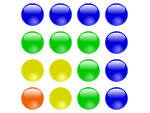 One of the more popular Mental Gym tutorials, probably because it's short and simple, is the Squaring 2-Digit Numbers Mentally tutorial.
One of the more popular Mental Gym tutorials, probably because it's short and simple, is the Squaring 2-Digit Numbers Mentally tutorial.
Playing around with the methods in the math section of that tutorial, and doing a little research, I've run across an interesting pattern that make the calculations even simpler.
I'd noticed a pattern in some of the squares concerning their last two digits, but never really thought about the possibilities until I ran across this page about squares.
I've reproduced a slightly modified version of the number arrangement from that page below, but with the last two digits of each square highlighted. Although it's not shown here, the 2-digit pattern does continue on forever.
As I mention in the original tutorial, memorizing the squares of the numbers 1 through 25 is the most basic starting point, as is knowing how to square 2-digit numbers ending in 5. From here, though, we can take advantage of the pattern above in a different way.
x x2 x x2 1 01 49 2401 2 04 48 2304 3 09 47 2209 4 16 46 2116 5 25 45 2025 6 36 44 1936 7 49 43 1849 8 64 42 1764 9 81 41 1681 10 100 40 1600 11 121 39 1521 12 144 38 1444 13 169 37 1369 14 196 36 1296 15 225 35 1225 16 256 34 1156 17 289 33 1089 18 324 32 1024 19 361 31 961 20 400 30 900 21 441 29 841 22 484 28 784 23 529 27 729 24 576 26 676 25 625
SQUARING NUMBERS 26-50: When asked to square a number from 26-50, take the distance from 25 to that number, and multiply it by 100. Next, square the distance from the given to number to 50, and add it to the previous number you calculated. Those 2 steps give you the square.
For example, let's square 27. 27 - 25 = 2, so you multiply 2 × 100 = 200. The distance from 27 to 50 is 23, which you should know by heart as 529. Add 200 + 529 = 729, and you've got the answer to 27 squared!
How about, say, 38? How far is that from 25? Yes, it's 13, so we start with 1300. How far is 38 from 50? It's 12, and 12 squared is 144. 1300 + 144 = 1444, so we know 38 squared is 1444!
This approach makes numbers in the 40s almost ridiculously easy to square. You just say their distance from 25, then their distance from 50 squared. For 42, which is 25 + 17, you'd say, “17...” then square 8 (the distance from 42 to 50) and say, "..64!" With a little practice, numbers in the 40s almost square themselves!
SQUARING NUMBERS 51-75: As I mentioned above, the squares of the numbers beyond 50 continue with this pattern. Here are the squares of the numbers from 51 to 75, and here are just the last digits of each of those numbers.
The method for squaring these numbers is slightly different. After you're given the number, work out its distance from 50, add 25 to that distance, then multiply by 100. The final step is to square the distance from 50 to the given number, and add that to your previous calculation.
Let's use 56 as our first example. 56 - 50 = 6, so we add 6 + 25 = 31, and multiply by 100 to get 3100. 56, as we've already worked out is 6 away from 50, so we square 6 to get 36. 3100 + 36 = 3136, which is 56 squared! Notice that the 50s almost multiply themselves, just like the 40s did above!
Can you handle, say, 67 squared? That's 17 away from 50, so we work out 17 + 25 = 42, and 42 × 100 = 4200. Next, 17 squared is 289 (you know that from memory, right?), so we add 4200 + 289 = 4489!
SQUARING NUMBERS BEYOND 75: Squaring the numbers from 76 up to 125 can be handled just as in the original tutorial. You'll probably understand why this approach works more completely after seeing the pattern above.
Perhaps you can work out a method for numbers beyond 125? It can be done, but it's more than a minor variation on the above patterns.




1 Response to Getting Squared Away
I've known about this pattern for awhile now. I've heard it referred to as quadrant symmetry. There is octant symmetry in the three digit ending of three digit squares. This is very useful in memorizing the squares and also allows one to extract integer square roots with four digit root numbers. The first two are estimated based on your knowledge of the squares and the last two are found by subtracting your two digit estimate and seeing which quadrant the last two digits belong. Mr. Cram perhaps can explain this method in a blog post. Or if you like I can send you a tutorial of this
Post a Comment